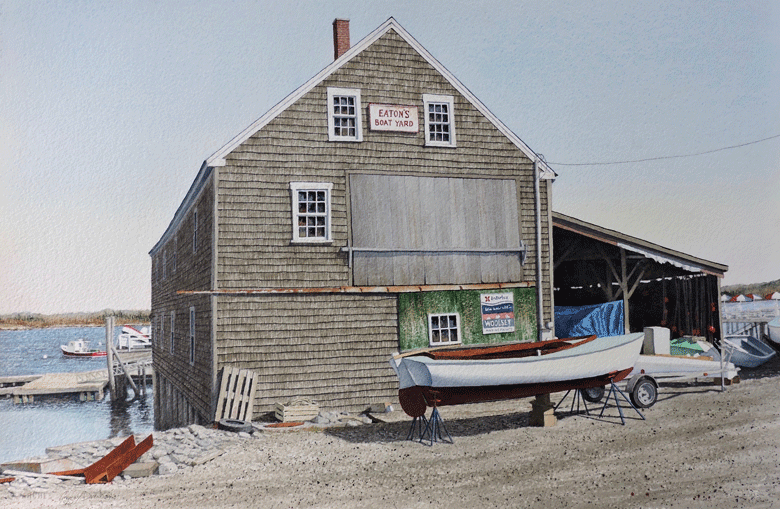In 1980, inspired by friend and mentor, the famed lithographer Stow Wengenroth (1906-1978), painter Gregory Dunham and his wife-to-be Pat McGrath decided to go on a “pilgrimage” to some of the Maine towns the artist had frequented in his lifetime.
From their home in Rockport, Mass., they drove straight to Eastport where Wengenroth’s love of Maine began in the 1930s and where its landscape inspired his first brilliant prints.
Over four days the couple squeezed in Eastport, along with Lubec, Corea, Winter Harbor, Castine, Port Clyde, Boothbay Harbor, Wiscasset, Kennebunkport, and Ogunquit. Seven years later, having considered their options, they moved to Castine with their nine-month-old son Stow and opened the McGrath Dunham Gallery.
The boatyard has provided a “nearly endless supply of inspiration,” Dunham writes…
In the 40-plus years since that fateful trip, Dunham has witnessed the slow—and sometimes not so slow—disappearance of the working waterfront as weathered wharves and fishing shacks give way to gentrification. These changes are in part what compels him to paint docks, sheds, skiffs—and Eaton’s boatyard in his adopted hometown.
The boatyard has provided a “nearly endless supply of inspiration,” Dunham writes, a subject to which he returns again and again—and will continue to do so “as long as it remains an active, cluttered working boatyard.”
In one of his paintings a Castine class sailboat, designed and built by the Eaton family, is parked in the yard, its lovely white hull set against the warm gray of the building.
“I love the shape and colors of wooden skiffs and dories and the stories they tell,” writes Dunham, “and I mourn their loss with the advent of Zodiacs.”
If you don’t count Maine Maritime Academy, the boatyard is pretty much the last bastion of marine business on the Castine shoreline. A recent walk-through confirmed its description in Philip Booth’s splendid poem, “Eaton’s Boatyard,” where he offers an inventory of some of the odds and ends you can find within, including “split rudders, / stripped outboards, half / a gasket, and nailsick garboards.”
But the visit also verified the comeliness of the place as depicted in Dunham’s painting: the weathered shingles, the simple signage—the nobility, if you will, of the structure.
Dunham is a watercolor painter of the first order, known for his landscapes of Maine, Canada, England, and other places connected to the sea. Asked what it is that draws him to paint harbors, he shares the most obvious reason, their picturesqueness, but also expresses his desire to document them before they’re gone.
Dunham says he feels “comfortable and at home” in the dockside milieu. While he loves Maine’s rugged coast and crashing surf, it’s the working harbors that inspire and comfort him.
“The weather-beaten fish houses and wharves on spindly pilings that stand against the tides and wind tell stories of hardship, bravery, independence, and fortitude,” he writes.
On a visit to Mousehole in Cornwall, England, in 1999, Dunham felt the seaside town was somehow embedded in his genes, that he must have an ancestral connection to it. That experience underscores why he ended up in Rockport and then Castine, “intrigued,” he says, by coastal towns “with the color and action around the docks, the smell of salt air, and, of course, the light.”
Dunham is represented by Gallery B in Castine, Full Fathom Five Gallery in Eastport, and the Patricia Hutton Galleries in Doylestown, Penn. You can view more of his work at www.gregorydunham.com. Two of his paintings will appear in Carl and David Little’s forthcoming book The Art of Penobscot Bay (Islandport Press). To learn about the history of Eaton’s boatyard, visit the “Living History” page on the Castine Historical Society website.





